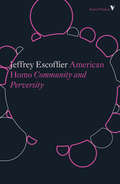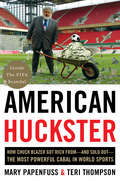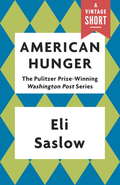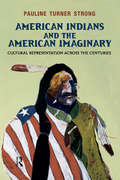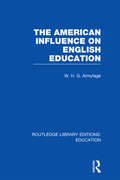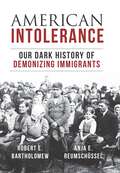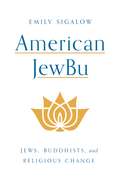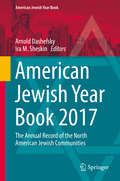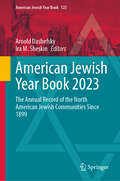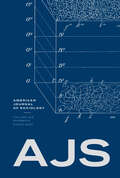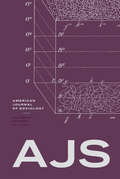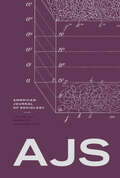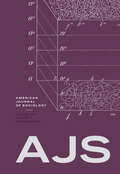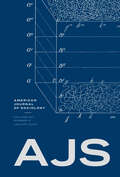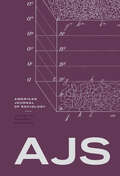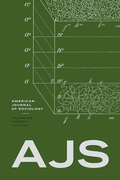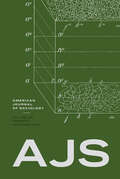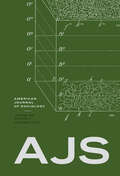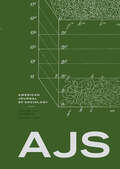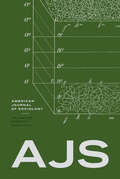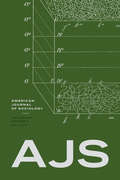- Table View
- List View
American Homelessness: A Reference Handbook (3rd edition)
by Mary Ellen HombsHombs (of the Massachusetts Housing and Shelter Alliance) offers a collection of reference materials that provide information on the pervasive problem of homelessness in the United States. Nine chapters offer a chronology of the homeless problem, brief biographical sketches of 20 people who have had an effect on homeless policy and research, statistical information, documents and government reports, legislation from the U.S. and Europe written to address the problem, a list of print and nonprint resources, and a directory of organizations and government agencies. Also included is a brief analysis and discussion of the problem, comparing Europe and the United States.
American Homo: Community and Perversity
by Jeffrey EscoffierA sweeping account of the way lesbian, gay, and bisexual people have challenged and changed societyIn this provocative book, Jeffrey Escoffier tracks LGBT movements across the contested terrain of American political life, where they have endured the historical tension between the homoeroticism coursing through American culture and the virulent periodic outbreaks of homophobic populism. Escoffier explores how every new success enables a new disciplinary and normalizing form of domination; only the active exercise of democratic rights and participation in radical coalitions allows LGBT people to sustain the benefits of community and the freedom of sexual perversity.
American Huckster: How Chuck Blazer Got Rich From-and Sold Out-the Most Powerful Cabal in World Sports
by Teri Thompson Mary PapenfussThe first inside account of the international soccer scandal that rocked the world and the American at its center--the incredible story of how a stay-at-home New York soccer dad illegally made millions off the world's most powerful and corrupt sports organization and became an unlikely FBI whistleblower. <P><P>He was the middle-class Jewish kid from Queens who rose from local youth soccer leagues to the heights of FIFA, becoming a larger-than-life, jet-setting buccaneer--and the most notorious FBI informant in sports history. For years, Chuck Blazer skimmed over $20 million from FIFA, stashing his money in offshore accounts and real estate holdings that included a luxury apartment in Trump Tower, a South Beach condo, and a hideaway in the Bahamas. Instantly recognizable with his unruly mass of salt-and-pepper hair and matching beard--and a rotating crop of arm candy--Blazer was one of the most flamboyant figures in the glitzy social and political circles of international soccer. <P>Over the course of thirty years, Blazer leveraged his friendships with the likes of Vladimir Putin, Hillary Clinton and Nelson Mandela, to increase his influence with the mandarins of global soccer--most notably Sepp Blatter, FIFA's long-time godfather.Once Blatter tapped Blazer to be the first American in almost fifty years to sit on FIFA's executive committee, the erstwhile accountant steadily accumulated money and power--until 2013 when the FBI and IRS nabbed Blazer and charged him with fraud, money laundering, and tax evasion. <P>In exchange for immunity, Blazer agreed to let the Feds install a microphone in his keychain to entrap his larcenous band of brothers--leading to the shocking arrest and indictment of eighteen FIFA officials for racketeering and bribery. <P>In this taut and suspenseful tale of white-collar crime and betrayal at the highest levels of international business, investigative reporters Mary Papenfuss and Teri Thompson draw on sources in U.S. law enforcement as well as in Blazer's inner circle to tell the surreal tale of this astonishing character and the scandal that rocked the world.
American Hunger
by Eli SaslowAn eBook short.Winner of the Pulitzer Prize for Explanatory ReportingIn this Pulitzer Prize-winning collection, Washington Post reporter Eli Saslow traveled across the country over the course of a year--from Florida and Texas to Rhode Island and Tennessee--to examine the personal and political implications and repercussions of America's growing food stamp program. Saslow shows us the extraordinary impact the arrival of food stamps has each month on a small town's struggling economy, the difficult choices our representatives face in implementing this $78-billion program affecting millions of Americans, and the challenges American families, senior citizens, and children encounter every day in ensuring they have enough, and sometimes even anything to eat. These unsettling and eye-opening stories make for required reading, providing nuance and understanding to the complex matters of American poverty.
American Identity and the Politics of Multiculturalism
by David O. Sears Jack CitrinThe civil rights movement and immigration reform transformed American politics in the mid-1960s. Demographic diversity and identity politics raised the challenge of e pluribus unum anew, and multiculturalism emerged as a new ideological response to this dilemma. This book uses national public opinion data and public opinion data from Los Angeles to compare ethnic differences in patriotism and ethnic identity and ethnic differences in support for multicultural norms and group-conscious policies. The authors find evidence of strong patriotism among all groups and the classic pattern of assimilation among the new wave of immigrants. They argue that there is a consensus in rejecting harder forms of multiculturalism that insist on group rights but also a widespread acceptance of softer forms that are tolerant of cultural differences and do not challenge norms, such as by insisting on the primacy of English.
American Idle: Late-Career Job Loss in a Neoliberal Era (Inequality at Work: Perspectives on Race, Gender, Class, and Labor)
by Annette Nierobisz Dana Sawchuk Dana Sawchuck Annette Marie NierobiszIn American Idle, sociologists Annette Nierobisz and Dana Sawchuk report their findings from interviews with sixty-two mostly white-collar workers who experienced late-career job loss in the wake of the Great Recession. Without the benefits of planned retirement or time horizons favorable to recouping their losses, these employees experience an array of outcomes, from hard falls to soft landings. Notably, the authors find that when reflecting on the effects of job loss, fruitless job searches, and the overall experience of unemployment, participants regularly called on the frameworks instilled by neoliberalism. Invoking neoliberal rhetoric, these older Americans deferred to businesses’ need to prioritize bottom lines, accepted the shift toward precarious employment, or highlighted the importance of taking initiative and maintaining a positive mindset in the face of structural obstacles. Even so, participants also recognized the incompatibility between neoliberalism’s “one-size-fits-all” solutions and their own situations; this disconnect led them to consider their experiences through competing frameworks and to voice resistance to aspects of neoliberal capitalism. Employing a life course sociology perspective to explore older workers’ precarity in an age of rising economic insecurity, Nierobisz and Sawchuk shed light on a new wrinkle in American aging.
American Indians and the American Dream: Policies, Place, and Property in Minnesota
by Kasey R. KeelerUnderstanding the processes and policies of urbanization and suburbanization in American Indian communities Nearly seven out of ten American Indians live in urban areas, yet studies of urban Indian experiences remain scant. Studies of suburban Natives are even more rare. Today&’s suburban Natives, the fastest-growing American Indian demographic, highlight the tensions within federal policies working in tandem to move and house differing groups of people in very different residential locations. In American Indians and the American Dream, Kasey R. Keeler examines the long history of urbanization and suburbanization of Indian communities in Minnesota.At the intersection of federal Indian policy and federal housing policy, American Indians and the American Dream analyzes the dispossession of Indian land, property rights, and patterns of home ownership through programs and policies that sought to move communities away from their traditional homelands to reservations and, later, to urban and suburban areas. Keeler begins this analysis with the Homestead Act of 1862, then shifts to the Indian Reorganization Act in the early twentieth century, the creation of Little Earth in Minneapolis, and Indian homeownership during the housing bubble of the early 2000s.American Indians and the American Dream investigates the ways American Indians accessed homeownership, working with and against federal policy, underscoring American Indian peoples&’ unequal and exclusionary access to the way of life known as the American dream. Cover alt text: Vintage photo of Native person bathing smiling child in the sink of a midcentury kitchen. Title in yellow.
American Indians and the American Imaginary: Cultural Representation Across the Centuries
by Pauline Turner StrongAmerican Indians and the American Imaginary considers the power of representations of Native Americans in American public culture. The book's wide-ranging case studies move from colonial captivity narratives to modern film, from the camp fire to the sports arena, from legal and scholarly texts to tribally-controlled museums and cultural centres. The author's ethnographic approach to what she calls "representational practices" focus on the emergence, use, and transformation of representations in the course of social life. Central themes include identity and otherness, indigenous cultural politics, and cultural memory, property, performance, citizenship and transformation. American Indians and the American Imaginary will interest general readers as well as scholars and students in anthropology, history, literature, education, cultural studies, gender studies, American Studies, and Native American and Indigenous Studies. It is essential reading for those interested in the processes through which national, tribal, and indigenous identities have been imagined, contested, and refigured.
American Influence on English Education (Routledge Library Editions: Education)
by W H ArmytageThe American ideal has exercised a powerful influence over English educational policy over the last two centuries, even as it has itself changed. Today the very size of America enables it to rehearse problems we shall meet tomorrow. This volume answers key questions for education, as relevant now as they were when it was originally published: Is there an optimal size and a maximal use of a school? Are there adequately sophisticated batteries of attainment tests? Or valid methods of vocational guidance?
American Intolerance: Our Dark History of Demonizing Immigrants
by Robert E. Bartholomew Anja ReumschuesselThis historical review of the US treatment of immigrants and minority groups documents the suspicion and persecution that often met newcomers and those perceived to be different. Contrary to popular belief, the poor and huddled masses were never welcome in America. Though the engraving on the base of the Statue of Liberty makes that claim, history reveals a far less-welcoming message. This comprehensive survey of cultural and racial exclusion in the United States examines the legacy of hostility toward immigrants over two centuries. The authors document abuses against Catholics in the early 19th century in response to the influx of German and Irish immigrants; hostility against Mexicans throughout the Southwest, where signs in bars and restaurants read, "No Dogs, No Negros, No Mexicans"; "yellow peril" fears leading to a ban on Chinese immigration for ten years; punitive measures against Native Americans traditions, which became punishable by fines and hard labor; the persecution of German Americans during World War I and Japanese Americans during World War II; the refusal to admit Jewish refugees of the Holocaust; and the ongoing legacy of mistreating African Americans from slavery to the injustices of the present day. Though the authors note that the United States has accepted tens of millions of immigrants during its relatively short existence, its troubling history of persecution is often overlooked. President Donald Trump's targeting of Muslim and Mexican immigrants is just the most recent chapter in a long, sad history of social panics about "evil" foreigners who are made scapegoats due to their ethnicity or religious beliefs.
American JewBu: Jews, Buddhists, and Religious Change
by Emily SigalowA revealing look at the Jewish American encounter with BuddhismToday, many Jewish Americans are embracing a dual religious identity, practicing Buddhism while also staying connected to their Jewish roots. This book tells the story of Judaism's encounter with Buddhism in the United States, showing how it has given rise to new contemplative forms within American Judaism—and shaped the way Americans understand and practice Buddhism.Taking readers from the nineteenth century to today, Emily Sigalow traces the history of these two traditions in America and explains how they came together. She argues that the distinctive social position of American Jews led them to their unique engagement with Buddhism, and describes how people incorporate aspects of both into their everyday lives. Drawing on a wealth of original in-depth interviews conducted across the nation, Sigalow explores how Jewish American Buddhists experience their dual religious identities. She reveals how Jewish Buddhists confound prevailing expectations of minority religions in America. Rather than simply adapting to the majority religion, Jews and Buddhists have borrowed and integrated elements from each other, and in doing so they have left an enduring mark on the American consciousness.American JewBu highlights the leading role that American Jews have played in the popularization of meditation and mindfulness in the United States, and the profound impact that these two venerable traditions have had on one another.
American Jewish Year Book 2017: The Annual Record of the North American Jewish Communities (American Jewish Year Book #117)
by Arnold Dashefsky Ira M. SheskinThe American Jewish Year Book, now in its 117th year, is the annual record of the North American Jewish communities and provides insight into their major trends. The first chapter of Part I is an examination of how American Jews fit into the US religious landscape, based on Pew Research Center studies. The second chapter examines intermarriage. Chapters on "The Domestic Arena" and "The International Arena" analyze the year's events as they affect American Jewish communal and political affairs. Three chapters analyze the demography and geography of the US, Canada, and world Jewish populations. Part II provides lists of Jewish institutions, including federations, community centers, social service agencies, national organizations, synagogues, Hillels, day schools, camps, museums, and Israeli consulates. The final chapters present national and local Jewish periodicals and broadcast media; academic resources, including Jewish Studies programs, books, journals, articles, websites, and research libraries; and lists of major events in the past year, Jewish honorees, and obituaries.
American Jewish Year Book 2023: The Annual Record of the North American Jewish Communities Since 1899 (American Jewish Year Book #123)
by Arnold Dashefsky Ira M. SheskinAcross three centuries, AJYB has provided insight into major trends. Part I of the current volume contains eight chapters: The first lead chapter includes an Audit of Antisemitic Incidents in 2023 produced by the ADL, and the second chapter examines Denominational Identity and Jewish Engagement. Subsequent chapters analyze recent domestic and international events as they affect the American Jewish community, major events in the past year, and the demography and geography of the US, Canada, and World Jewish populations. Part II contains nine chapters: lists of local Jewish organizations; Jewish museums, and Holocaust museums and monuments; overnight camps; national Jewish organizations; Jewish press; Jewish academic programs; Jewish academic resources; Jewish honorees; and Jewish obituaries. This volume employs an accessible style, making it of interest to public officials, Jewish professional and lay leaders, as well as the general public and academic researchers. For more than a century, the American Jewish Year Book has served as an indispensable compendium of Jewish demographic trends, research and data. It is considered a must-read for data scientists, demographers, community leaders or anyone interested in the trends that make up the lifeblood of the Jewish experience in America. We are proud of our contributions to this essential resource. Jonathan A. Greenblatt, CEO and National Director of ADL (the Anti-Defamation League) The American Jewish Year Book is a unique resource of tremendous value to anyone interested in global Jewish life. It is critical for people today, and it will be for those who come after us. Its lists capture not only critical information about key aspects of Jewish communal life, but provide the opportunity for reflection, comparison, and analysis with other religious and ethnic communities. Riv-Ellen Prell, Professor Emerita, American Studies and the Center for Jewish Studies, University of Minnesota
American Journal of Sociology, volume 126 number 5 (March 2021)
by American Journal of SociologyThis is volume 126 issue 5 of American Journal of Sociology. American Journal of Sociology (AJS) presents pathbreaking work from all areas of sociology, with an emphasis on theory building and innovative methods. AJS strives to speak to the general sociology reader and is open to contributions from across the social sciences—sociology, political science, economics, history, anthropology, and statistics—that seriously engage the sociological literature to forge new ways of understanding the social. AJS offers a substantial book review section that identifies the most salient work of both emerging and enduring scholars of social science. Commissioned review essays appear occasionally, offering readers a comparative, in-depth examination of prominent titles.
American Journal of Sociology, volume 127 number 1 (July 2021)
by American Journal of SociologyThis is volume 127 issue 1 of American Journal of Sociology. American Journal of Sociology (AJS) presents pathbreaking work from all areas of sociology, with an emphasis on theory building and innovative methods. AJS strives to speak to the general sociology reader and is open to contributions from across the social sciences—sociology, political science, economics, history, anthropology, and statistics—that seriously engage the sociological literature to forge new ways of understanding the social. AJS offers a substantial book review section that identifies the most salient work of both emerging and enduring scholars of social science. Commissioned review essays appear occasionally, offering readers a comparative, in-depth examination of prominent titles.
American Journal of Sociology, volume 127 number 2 (September 2021)
by American Journal of SociologyThis is volume 127 issue 2 of American Journal of Sociology. American Journal of Sociology (AJS) presents pathbreaking work from all areas of sociology, with an emphasis on theory building and innovative methods. AJS strives to speak to the general sociology reader and is open to contributions from across the social sciences—sociology, political science, economics, history, anthropology, and statistics—that seriously engage the sociological literature to forge new ways of understanding the social. AJS offers a substantial book review section that identifies the most salient work of both emerging and enduring scholars of social science. Commissioned review essays appear occasionally, offering readers a comparative, in-depth examination of prominent titles.
American Journal of Sociology, volume 127 number 3 (November 2021)
by American Journal of SociologyThis is volume 127 issue 3 of American Journal of Sociology. American Journal of Sociology (AJS) presents pathbreaking work from all areas of sociology, with an emphasis on theory building and innovative methods. AJS strives to speak to the general sociology reader and is open to contributions from across the social sciences—sociology, political science, economics, history, anthropology, and statistics—that seriously engage the sociological literature to forge new ways of understanding the social. AJS offers a substantial book review section that identifies the most salient work of both emerging and enduring scholars of social science. Commissioned review essays appear occasionally, offering readers a comparative, in-depth examination of prominent titles.
American Journal of Sociology, volume 127 number 4 (January 2022)
by American Journal of SociologyThis is volume 127 issue 4 of American Journal of Sociology. American Journal of Sociology (AJS) presents pathbreaking work from all areas of sociology, with an emphasis on theory building and innovative methods. AJS strives to speak to the general sociology reader and is open to contributions from across the social sciences—sociology, political science, economics, history, anthropology, and statistics—that seriously engage the sociological literature to forge new ways of understanding the social. AJS offers a substantial book review section that identifies the most salient work of both emerging and enduring scholars of social science. Commissioned review essays appear occasionally, offering readers a comparative, in-depth examination of prominent titles.
American Journal of Sociology, volume 127 number 5 (March 2022)
by American Journal of SociologyThis is volume 127 issue 5 of American Journal of Sociology. American Journal of Sociology (AJS) presents pathbreaking work from all areas of sociology, with an emphasis on theory building and innovative methods. AJS strives to speak to the general sociology reader and is open to contributions from across the social sciences—sociology, political science, economics, history, anthropology, and statistics—that seriously engage the sociological literature to forge new ways of understanding the social. AJS offers a substantial book review section that identifies the most salient work of both emerging and enduring scholars of social science. Commissioned review essays appear occasionally, offering readers a comparative, in-depth examination of prominent titles.
American Journal of Sociology, volume 128 number 1 (July 2022)
by American Journal of SociologyThis is volume 128 issue 1 of American Journal of Sociology. American Journal of Sociology (AJS) presents pathbreaking work from all areas of sociology, with an emphasis on theory building and innovative methods. AJS strives to speak to the general sociology reader and is open to contributions from across the social sciences—sociology, political science, economics, history, anthropology, and statistics—that seriously engage the sociological literature to forge new ways of understanding the social. AJS offers a substantial book review section that identifies the most salient work of both emerging and enduring scholars of social science. Commissioned review essays appear occasionally, offering readers a comparative, in-depth examination of prominent titles.
American Journal of Sociology, volume 128 number 2 (September 2022)
by American Journal of SociologyThis is volume 128 issue 2 of American Journal of Sociology. American Journal of Sociology (AJS) presents pathbreaking work from all areas of sociology, with an emphasis on theory building and innovative methods. AJS strives to speak to the general sociology reader and is open to contributions from across the social sciences—sociology, political science, economics, history, anthropology, and statistics—that seriously engage the sociological literature to forge new ways of understanding the social. AJS offers a substantial book review section that identifies the most salient work of both emerging and enduring scholars of social science. Commissioned review essays appear occasionally, offering readers a comparative, in-depth examination of prominent titles.
American Journal of Sociology, volume 128 number 3 (November 2022)
by American Journal of SociologyThis is volume 128 issue 3 of American Journal of Sociology. American Journal of Sociology (AJS) presents pathbreaking work from all areas of sociology, with an emphasis on theory building and innovative methods. AJS strives to speak to the general sociology reader and is open to contributions from across the social sciences—sociology, political science, economics, history, anthropology, and statistics—that seriously engage the sociological literature to forge new ways of understanding the social. AJS offers a substantial book review section that identifies the most salient work of both emerging and enduring scholars of social science. Commissioned review essays appear occasionally, offering readers a comparative, in-depth examination of prominent titles.
American Journal of Sociology, volume 128 number 4 (January 2023)
by American Journal of SociologyThis is volume 128 issue 4 of American Journal of Sociology. American Journal of Sociology (AJS) presents pathbreaking work from all areas of sociology, with an emphasis on theory building and innovative methods. AJS strives to speak to the general sociology reader and is open to contributions from across the social sciences—sociology, political science, economics, history, anthropology, and statistics—that seriously engage the sociological literature to forge new ways of understanding the social. AJS offers a substantial book review section that identifies the most salient work of both emerging and enduring scholars of social science. Commissioned review essays appear occasionally, offering readers a comparative, in-depth examination of prominent titles.
American Journal of Sociology, volume 128 number 5 (March 2023)
by American Journal of SociologyThis is volume 128 issue 5 of American Journal of Sociology. American Journal of Sociology (AJS) presents pathbreaking work from all areas of sociology, with an emphasis on theory building and innovative methods. AJS strives to speak to the general sociology reader and is open to contributions from across the social sciences—sociology, political science, economics, history, anthropology, and statistics—that seriously engage the sociological literature to forge new ways of understanding the social. AJS offers a substantial book review section that identifies the most salient work of both emerging and enduring scholars of social science. Commissioned review essays appear occasionally, offering readers a comparative, in-depth examination of prominent titles.
American Journal of Sociology, volume 128 number 6 (May 2023)
by American Journal of SociologyThis is volume 128 issue 6 of American Journal of Sociology. American Journal of Sociology (AJS) presents pathbreaking work from all areas of sociology, with an emphasis on theory building and innovative methods. AJS strives to speak to the general sociology reader and is open to contributions from across the social sciences—sociology, political science, economics, history, anthropology, and statistics—that seriously engage the sociological literature to forge new ways of understanding the social. AJS offers a substantial book review section that identifies the most salient work of both emerging and enduring scholars of social science. Commissioned review essays appear occasionally, offering readers a comparative, in-depth examination of prominent titles.

